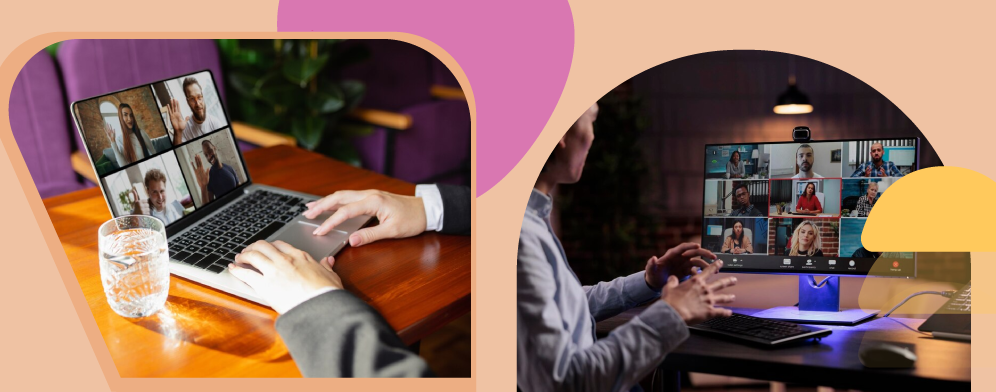1. Virtual Meeting Best Practices
The most important rule of remote tribe is growing is to plan them ahead. How many times and types of meetings are you intending to conduct? This helps you create categories by the priority of virtual meetings. Also, is attendance mandatory for some, and optional for others?
Keeping the meeting relevant to the attendees ensures no one’s time is wasted. The goal is to get straight to the point and know what is going on. Remote meeting best practices include
1.1. Leveraging the Right Tools

The right tool differs by your needs. Will the tool suffice for all your meetings? For example, if you hold video calls, broadcast events or run conferences, it makes sense to use a video conference platform. These tools have superior audio and video technology. They also allow mass participation and verify the identity of participants before letting them in.
On the other hand, if you're holding your meetings internally with small sized teams, you’ll need a remote collaboration software that is easy to navigate and makes it easy to share screens, set notifications, alerts, reminders and mentions.
1.2. Speaking Turns
In meetings, the goal is to get everyone to contribute. In reality, however, not everyone manages to get a word in. Some participants end up dominating the discussion and steamrolling over everybody else. An important rule that you should reiterate before the meeting kicks off, is that everyone in attendance should get a fair chance to speak up. If you observe the average time each participant takes to present their points, you’ll be able to set realistic time limits for future meetings.
1.3. Keep the Camera On
When and where possible, have your camera on and insist on the other attendees doing so. It helps you observe each other’s cues. This rule applies even when conducting remote interviews. With the camera on, you will tend to make eye contact more often with your teammates and stay in the present. If meetings are long, people tend to zone out, which are more evident visually.
1.4. Fixing Time Limits
It's a fact; meetings that go on for long cause people to lose interest in what is being said. Given that attention spans fluctuate, it's important to trim your meetings to the essentials. Establish an agenda and rules of discussion before dialing everyone and adding them to the meeting. Conduct your virtual meetings at agreed times so that people can move things around their schedule and join in.
1.5. Predetermine Everyone’s Availability
With a distributed set of remote workers, you’ll need to plug in a time zone or calendar app to find timings that work for everyone you need in the meeting. Categorize work calls by their priority and make time for informal team-building activities as well. It keeps things interesting and helps people recharge.
1.6. Find a Secluded Space
Last, but not least, make sure that you can take your call in peace. Find a quiet spot and use background noise blocking apps like Freedom or Krisp to have a smooth and clear call. A noisy environment can be distracting for both the speaker as well as the audience, so set aside a workspace where you’re unlikely to be interrupted or distracted in the middle of a virtual meeting.
2. How do You Run a Virtual Meeting?

The first step to run a virtual meeting is to create meeting links to a video conferencing software(such as Zoom, or Skype) that your attendees can login to. Once they login, the moderator has to confirm their identities in a staging area until every confirmed participant joins in.
The success of a virtual meeting hinges on who facilitates, moderates and participates in it. A facilitator initiates discussions, while a moderator ensures that everyone maintains civility and accuracy when presenting. It is important to work on your own communication and leadership skills in order to ensure meetings stay on track.
If you’re adding new hires or a team member from a different department to a group call, make sure to introduce everyone before getting down to business. Use an ice breaker question to get meeting participants to relax. It can be something related to weekend plans, hobbies, a favorite movie or sport. Test out the meeting software’s audio, video, screen sharing and recording options before running the meeting. If you plan ahead, you can prepare for both the meeting as well for any technical glitches that may occur.
Before getting into online meetings, remember to organize your information into talking points. Make a habit of starting and ending your meetings on time. It discourages habitual latecomers or early dropouts. When you’re reaching the end of one topic, make it clear to attendees that you’re moving on through your tone or pace of delivery.
And finally, avoid arranging meetings that fall outside a participant’s usual work hours, unless they tell you that such and such time works for them.
3. Do’s and Don'ts of Virtual Meetings
3.1. REMOTE MEETINGS DO’s
3.1.1. Choose the Right Communication Tools
The remote communication tool you choose to conduct meetings should enable joinees to contribute to the discussion actively. It should contain presenting options, and muting and unmuting as the speakers change. It should record notes to summarize the discussion.
3.1.2. Test the Audio and Video before it Commences
Useful virtual meeting best practices include rehearsing meetings before the actual event. If you’re trying out a new tool, run practice sessions internally with team members. Let customer support know if anyone is experiencing problems connecting or with audio and video.
3.1.3. Create an Agenda and Time Limit
Every meeting should have a point to it. If it can be conveyed over an email, then there’s no need to schedule a discussion. Watch the clock to make sure meetings don’t eat too much into the work hours available, particularly if members are up against a project deadline and need all the time they can get to finish.
3.1.4. Look into Everyone’s Individual Availability
People who are busy, or unaware of such a meeting taking place can hold up the people who have already joined in. Never schedule a meeting without making sure everyone can make it. Recheck if anyone’s on leave, busy with work or in another discussion.
3.1.5. Mute yourself When your Turn is Over
Out of courtesy, mute your mic until it's your turn or after your turn ends. Interrupting a speaker when they’re still talking is distracting at best, and at worst, annoying. Make sure your environment is noise-free.
3.1.6. Unmute yourself to Respond to Questions
If you’ve muted yourself, remember to unmute to respond to questions someone directs at you. You’ll have to pay attention to audio cues.
3.1.7. Pay Attention
Avoid opening other websites and applications that can distract you. When you’re in the meeting, pay attention to that and only that. Do not multitask because you can get caught unawares if and when someone asks for your input.
3.1.8. Take Notes or Record as Required
Depending on the type of meeting taking place, get permission before recording discussions. Take notes where required so that you can recap as the meeting wraps up, and have information that may be useful for the next meeting.
3.1.9. Recap the Meeting and Send out a Summary Over Email
It helps to have a quick recap before the meeting concludes. You can expand on your notes and email the minutes to attendees to refer to.
3.2. REMOTE MEETING DON’TS
3.2.1. Take the Meeting in Crowded and Noisy Locations
Crowded places are the last place to take important meetings in. You won’t be audible and you’ll wind up distracting everybody else by dropping in and out of the discussion. If you absolutely cannot find a peaceful, quiet place, do remember to excuse yourself in writing and exit so that others may continue without you.
3.2.2. Cut Across an Active Speaker
It is rude to cut someone off mid sentence. An important remote meeting etiquette is to wait till the floor is open for questions. If you have objections or feedback, make a note of it and make sure they’ve finished speaking before raising your hand.
3.2.3. Take a Backseat
Remote workers have to be more intentional about establishing their presence. While they themselves can be visible, their contribution can risk staying invisible if they do not add to the discussion.
3.2.4. Fake Emergencies to Get Out of the Meeting
Don’t invent an emergency to get out of a crucial check-in or status update. If you have committed to a scheduled meeting, do everything in your capacity to attend it. If it's a genuine, last-minute reason, let your team lead or a fellow coworker know.
3.2.5. Invite Everyone
Not every meeting needs every single team member. Agenda differs from meeting to meeting. A daily stand-up, for example, is to get an idea of the progress so far. But a strategy meeting is to communicate new goals and the approach to execute it. Decide who to add to the meeting based on the type of discussion it will be, and their role in it.
3.2.6. Put a Coworker Down
Never publicly put someone down with everyone listening in. It invites resentment and creates workplace conflict unnecessarily. While you’re entitled to disagree, you should convey your opinions respectfully but firmly. And don’t let bullying behavior off the hook if you observe it in meetings. Always attempt to diffuse the situation and schedule a separate call with the disagreeing parties to reiterate meeting policies
4. How Do you Make a Virtual Meeting More Effective?
Virtual meeting best practices are more effective when they are standardized, organized and categorized. Put simply, not everything needs a meeting. Running virtual meetings with purpose ensures you are informed of activities, and the status of tasks.
It helps team members know what coworkers are working on and whether they could use a hand or are free to lend others a hand! A virtual meeting provides information and allows everyone to go over what they have accomplished. It is a forum for managers to highlight performance expectations and appreciate well-performing members.
Which of these virtual meeting best practices do you agree with, and what would you add to this?
5. FAQs
5.1. How do you facilitate a virtual meeting?
To facilitate a virtual meeting, you must prepare an agenda beforehand. You need to ensure clear communication guidelines, and use interactive tools or features (like polls or breakout rooms) to engage participants actively during the virtual meeting.
















